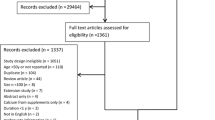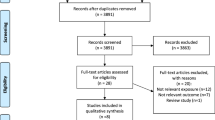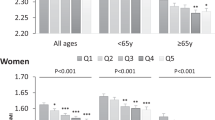Abstracts
Background/Objectives
To describe the associations of baseline dietary pattern scores with falls risk, bone mineral density (BMD), and incident fractures measured over 10 years in older adults.
Subjects/Methods
Dietary patterns were identified using exploratory factor analysis. Femoral neck (FN), hip, and lumbar spine (LS) BMD were measured using dual-energy X-ray absorptiometry, falls risk z-score using the Physiological Profile Assessment, and incident fractures by self-report. Linear mixed-effects models and log-binomial regression were used to estimate associations between baseline dietary pattern z-scores and outcomes.
Results
Of 1098 participants at baseline, 567 were retained over 10 years. Four dietary patterns were derived: fruit and vegetable (FV), animal protein (AP), snack, and Western. FV pattern reduced falls risk at baseline by β = 0.05–0.08/SD and the annual decreases of FN and hip BMD were less for higher Western or AP pattern scores in all populations and women. The annual increase in LS of the entire population was greater with higher scores of FV, AP, and Western patterns (all β = 0.001 g/cm2/year/SD, p < 0.05). Higher scores of FV and snack were associated with a higher risk of LS BMD increasing over 10 years (p < 0.05 for all, except snack pattern in men) and incident fracture was not associated with any dietary pattern in the overall cohort and both men and women separately.
Conclusions
An FV dietary pattern may be beneficial for reducing falls risk. The associations of dietary patterns and BMD are modest in magnitude and did not translate into an improved fracture risk. Associations between diet and LS BMD may reflect osteoarthritis rather than osteoporosis.
This is a preview of subscription content, access via your institution
Access options
Subscribe to this journal
Receive 12 print issues and online access
$259.00 per year
only $21.58 per issue
Buy this article
- Purchase on Springer Link
- Instant access to full article PDF
Prices may be subject to local taxes which are calculated during checkout

Similar content being viewed by others
References
Fung TT, Feskanich D. Dietary patterns and risk of hip fractures in postmenopausal women and men over 50 years. Osteoporos Int. 2015;26:1825–30.
Hernlund E, Svedbom A, Ivergård M, Compston J, Cooper C, Stenmark J, et al. Osteoporosis in the European Union: Medical management, epidemiology and economic burden. Arch Osteoporos. 2013;8:136.
Nasab SAM, Khorramdin E. The assessment of mortality and quality of life after intertrochanteric fracture of femur in patients older than 60 at Emam Khomeini Hospital of Ahvaz. Pak J Med Sci. 2017;33:895–8.
Burge R, Dawson‐Hughes B, Solomon DH, Wong JB, King A, Tosteson A. Incidence and Economic Burden of Osteoporosis‐Related Fractures in the United States, 2005–2025. J Bone Min Res. 2007;22:465–75.
Morrison A, Fan T, Sen SS, Weisenfluh L. Epidemiology of falls and osteoporotic fractures: A systematic review. Clinicoecon Outcomes Res. 2013;5:9.
Rianon NJ, Lang TF, Siggeirsdottir K, Sigurdsson G, Eiriksdottir G, Sigurdsson S, et al. Fracture risk assessment in older adults using a combination of selected quantitative computed tomography bone measures: a subanalysis of the age, gene/environment susceptibility-Reykjavik Study. J Clin Densitom. 2014;17:25–31.
Ebeling P, Daly R, Kerr D, Kimlin M. Building healthy bones throughout life. MJA. 2013;2:1–49.
Newby P, Tucker KL. Empirically derived eating patterns using factor or cluster analysis: a review. Nutr Rev. 2004;62:177–203.
Tucker KL. Dietary patterns, approaches, and multicultural perspective. Appl Physiol Nutr Metab. 2010;35:211–8.
Cade JE, Taylor EF, Burley VJ, Greenwood DC. Does the Mediterranean dietary pattern or the Healthy Diet Index influence the risk of breast cancer in a large British cohort of women? Eur J Clin Nutr. 2011;65:920–8.
Ocké MC. Evaluation of methodologies for assessing the overall diet: dietary quality scores and dietary pattern analysis. Proc Nutr Soc. 2013;72:191–9.
Fabiani R, Naldini G, Chiavarini M. Dietary patterns in relation to low bone mineral density and fracture risk: a systematic review and meta-analysis. Adv Nutr. 2019;10:219–36.
Ding C, Cicuttini F, Boon C, Boon P, Srikanth V, Cooley H, et al. Knee and hip radiographic osteoarthritis predict total hip bone loss in older adults: a prospective study. J Bone Min Res. 2010;25:858–65.
Gardener SL, Rainey-Smith SR, Barnes MB, Sohrabi HR, Weinborn M, Lim YY, et al. Dietary patterns and cognitive decline in an Australian study of ageing. Mol Psychiatry. 2015;20:860–6.
Keogh JB, Lange K, Syrette J. Comparative analysis of two FFQ. Public Health Nutr. 2010;13:1553–8.
Wu F, Wills K, Laslett LL, Oldenburg B, Jones G, Winzenberg T. Associations of dietary patterns with bone mass, muscle strength and balance in a cohort of Australian middle-aged women. Br J Nutr. 2017;118:598–606.
Williams B, Onsman A, Brown T. Exploratory factor analysis: A five-step guide for novices. J Emerg Prim Health Care. 2010;8:1–13.
Balogun S, Winzenberg T, Wills K, Scott D, Jones G, Aitken D, et al. Prospective associations of low muscle mass and function with 10-year falls risk, incident fracture and mortality in community-dwelling older adults. J Nutr Health Aging. 2017;21:843.
Scott D, Hayes A, Sanders KM, Aitken D, Ebeling PR, Jones G Operational definitions of sarcopenia and their associations with 5-year changes in falls risk in community-dwelling middle-aged and older adults. Osteoporos Int. 2014:187:187–93.
Nevitt MC, Cummings SR, Browner WS, Seeley DG, Cauley JA, Vogt SR, et al. The accuracy of self-report of fractures in elderly women: evidence from a prospective study. Am J Epidemiol. 1992;135:490–9.
Balogun S, Aitken D, Winzenberg T, Wills K, Scott D, Callisaya M, et al. Longitudinal associations of aerum 25-hydroxyvitamin D, physical activity, and knee pain and dysfunction with muscle loss in community-dwelling older adults. J Gerontol A Biol Sci Med Sci. 2017;00:1–6.
Jones G, White C, Sambrook P, Eisman J. Allelic variation in the vitamin D receptor, lifestyle factors and lumbar spinal degenerative disease. Ann Rheum Dis. 1998;57:94–9.
Livshits G, Ermakov S, Popham M, Macgregor AJ, Sambrook PN, Spector TD, et al. Evidence that bone mineral density plays a role in degenerative disc disease: the UK Twin Spine study. Ann Rheum Dis. 2010;69:2102–6.
Little RJ, Rubin DB Statistical analysis with missing data: John Wiley & Sons; 2014.
Rubin D Multiple Imputation for Nonresponse in Surveys. New York: John Wiley and Sons. 1987.
Laslett LL, Menz HB, Otahal P, Pan F, Cicuttini FM, Jones G. Factors associated with prevalent and incident foot pain: data from the tasmanian older adult cohort study. Maturitas 2018;118:38–43.
Mu M, Xu L-F, Hu D, Wu J, Bai M-J. Dietary patterns and overweight/obesity: a review article. Iran J Public Health. 2017;46:869–76.
StataCorp. Texax 77845 USA ed: College Station; 2016.
León-Muñoz LM, García-Esquinas E, López-García E, Banegas JR, Rodríguez-Artalejo F. Major dietary patterns and risk of frailty in older adults: a prospective cohort study. BMC Med. 2015;13:11.
Yin Z, Zhang J, Song P, Pang S, Zhao W, Zhai Y. et al. Dietary patterns associated with cognitive function among the older people in underdeveloped regions: Finding from the NCDFaC study. Nutrients. 2018;10:1–12.
Tucker KL, Chen H, Hannan MT, Adrienne Cupples L, Wilson PWF, Felson D, et al. Bone mineral density and dietary patterns in older adults: the Framingham Osteoporosis Study. Am J Clin Nutr. 2002;76:245–52.
Karamati M, Jessri M, Shariati-bafghi S-e, Rashidkhani B. Dietary patterns in relation to bone mineral density among menopausal Iranian women. Calcif Tissue Int. 2012;91:40–9.
Tenne M, McGuigan F, Besjakov J, Gerdhem P, Åkesson K. Degenerative changes at the lumbar spine—implications for bone mineral density measurement in elderly women. Osteoporos Int. 2013;24:1419–28.
Wirfält E, Drake I, Wallström P. What do review papers conclude about food and dietary patterns? Food Nutr Res. 2013;57:20523.
Markussen MS, Veierød MB, Kristiansen AL, Ursin G, Andersen LF. Dietary patterns of women aged 50–69 years and associations with nutrient intake, sociodemographic factors and key risk factors for non-communicable diseases. Public Health Nutr. 2016;19:2024–32.
Andreeva VA, Allès B, Feron G, Gonzalez R, Sulmont-Rossé C, Galan P, et al. Sex-specific sociodemographic correlates of dietary patterns in a large sample of French elderly individuals. Nutrients 2016;8:484.
Hsiao PY, Mitchell DC, Coffman DL, Allman RM, Locher JL, Sawyer P, et al. Dietary patterns and diet quality among diverse older adults: the university of Alabama at Birmingham study of aging. J Nutr Health Aging. 2013;17:19–25.
Harrington JM, Dahly DL, Fitzgerald AP, Gilthorpe MS, Perry IJ. Capturing changes in dietary patterns among older adults: a latent class analysis of an ageing Irish cohort. Public Health Nutr. 2014;17:2674–86.
Chan R, Chan D, Woo J. Associations between dietary patterns and demographics, lifestyle, anthropometry and blood pressure in Chinese community-dwelling older men and women. J Nutr Sci. 2012;1:e20–e.
Jomaa L, Hwalla N, Chamieh MC, Naja F, Itani L, Mehio-Sibai A. A Lebanese dietary pattern promotes better diet quality among older adults: findings from a national cross-sectional study. BMC Geriatr. 2016;16:85.
Abdollahi S, Zeinali F, Azam K, Toupchian O, Djafarian K. Identifying Major Dietary Patterns Among the Elderly in Tehran Health Homes. Jundishapur. J Health Sci. 2015;7:e30395.
Thorpe MG, Milte CM, Crawford D, McNaughton SA. A comparison of the dietary patterns derived by principal component analysis and cluster analysis in older Australians. Int J Behav Nutr Phys Act. 2016;13:1–14.
Funding
National Health and Medical Research Council of Australia (302204); Arthritis Foundation of Australia (MRI0616); Tasmanian Community Fund (D0015018); Masonic Centenary Medical Research Foundation; and University of Tasmania Institutional Research Grants Scheme (D0015019). HHN is supported by a scholarship of the University of Tasmania. FW is supported by a NHMRC Early Career Fellowship (APP1158661). GJ is supported by a Practitioner Fellowship, funded by the NHMRC Practitioner Fellowship (1117037).
Author information
Authors and Affiliations
Contributions
Chief Investigator of TASOAC Study: GJ. Study design: GJ and TW. Manuscript writing, data analysis and data interpretation: HHN. Expertise in statistics: KW. Providing advice relating to dietary patterns: WO and TW. Revising manuscript content: All authors. Responsibility for the final manuscript for publication: GJ.
Corresponding author
Ethics declarations
Conflict of interest
The authors declare that they have no conflict of interest.
Additional information
Publisher’s note Springer Nature remains neutral with regard to jurisdictional claims in published maps and institutional affiliations.
Rights and permissions
About this article
Cite this article
Nguyen, H.H., Wu, F., Oddy, W.H. et al. Associations between dietary patterns and osteoporosis-related outcomes in older adults: a longitudinal study. Eur J Clin Nutr 75, 792–800 (2021). https://doi.org/10.1038/s41430-020-00806-0
Received:
Revised:
Accepted:
Published:
Issue Date:
DOI: https://doi.org/10.1038/s41430-020-00806-0
This article is cited by
-
Energy Balance and Bone Health: a Nutrient Availability Perspective
Current Osteoporosis Reports (2023)
-
Associations between body composition, physical activity, and diet and radial bone microarchitecture in older adults: a 10-year population-based study
Archives of Osteoporosis (2022)



